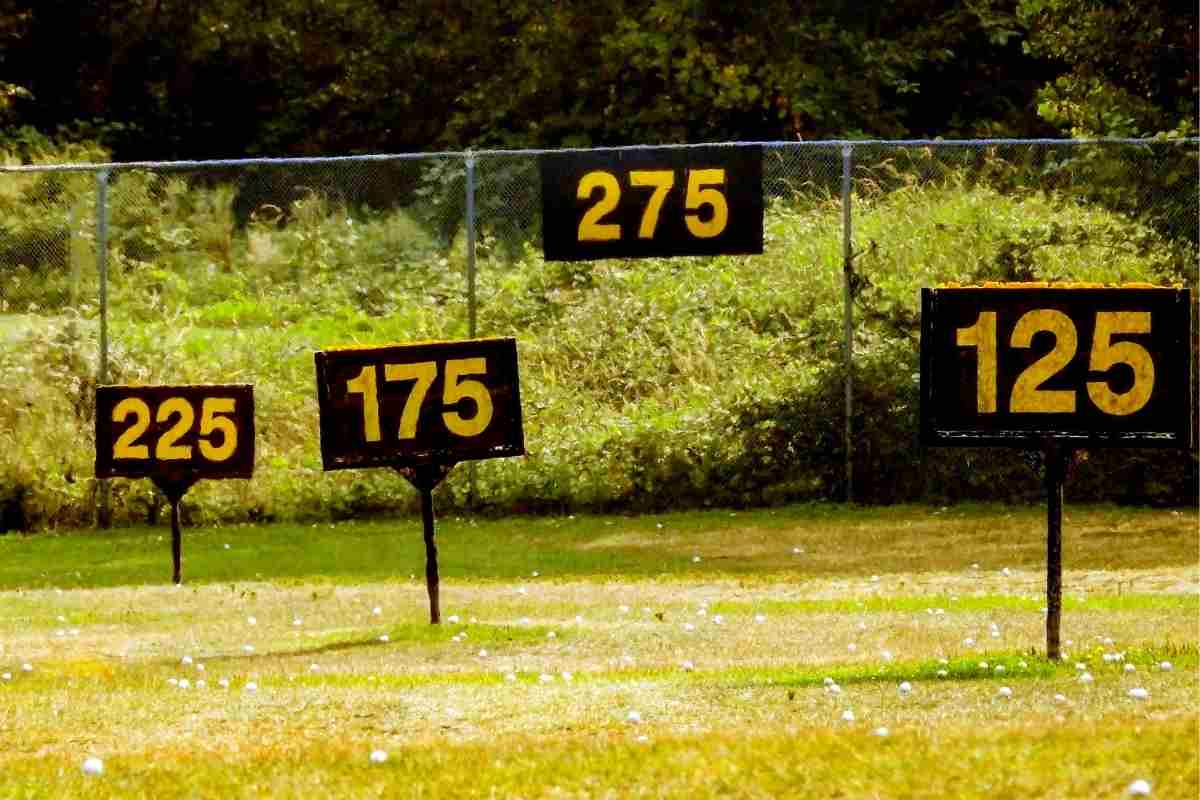Have you ever wondered how far you should hit each golf club in your bag? You are only allowed to carry 14 clubs while playing a round, so knowing how far you can hit each one is a key ingredient to playing your best golf. Let’s dive into how far the average golfer hits each club.
Average Golf Club Distances (by club type)
Driver
Amateur golfers drive the ball about 216 yards off the tee on average. That number encompasses all ages and skill levels. For a more detailed article on driver distance, check out this previous article.
Here’s a more detailed breakdown on driver distance:
- Average Male Golfer: 230 yards
- Average Female Golfer: 175 yards
- Average PGA Golfer: 294 yards
- Average LPGA Golfer: 244 yards
- Range for Men: 200-260 yards*
- Range for Women: 150-200 yards*
- (* means yardage depends on swing speed)
How much does a golfer’s swing speed factor into their driving distance? Quite a bit! Swing speed is all the rage these days, and if you’re watching a PGA tournament on the weekends, you’ll likely hear it mentioned on several occasions. Here’s a nice chart that shows the average PGA driver distance and swing speeds of each age group:
Related: Average Golf Driving Distances (By Age, Handicap & PGA Tour)
3 Wood
The 3 wood is the second-longest club in your bag when it’s hit solidly. A well-struck 3 wood shot will typically travel only 15-20 yards shorter than a driver off the tee. The 3 wood is difficult to hit out of the fairway for beginner-level golfers but can offer a huge advantage on Par 5’s and long Par 4’s.
- Average Male Golfer: 215 yards
- Average Female Golfer: 150 yards
- Average PGA Golfer: 275 yards
- Average LPGA Golfer: 225 yards
- Range for Men: 180-235 yards*
- Range for Women: 125-180 yards*
5 Wood
The 5 wood is similar to the 3 wood but with a bit of extra loft. The 5 wood is great to use when hitting out the fairway or a light rough. Men with a fast swing speed can hit a 5 wood about 210 yards, while women with a fast swing speed can knock it 170 yards.
- Average Male Golfer: 200 yards
- Average Female Golfer: 140 yards
- Average PGA Golfer: 250 yards
- Average LPGA Golfer: 200 yards
- Range for Men: 160-220 yards*
- Range for Women: 110-170 yards*
3 Hybrid
(Side note: Because most golfers use hybrids these days, I did not put in the data for a 3-iron)
These days, lots of golfers opt to use a hybrid instead of a long iron because they are much easier to hit. The new technology involved in manufacturing hybrids causes them to be more forgiving than the long irons. Here’s the info on the 3 hybrid:
- Average Male Golfer: 190 yards
- Average Female Golfer: 130 yards
- Average PGA Golfer: 230 yards
- Average LPGA Golfer: 190 yards
- Range for Men: 160-200 yards*
- Range for Women: 100-160 yards
4 Iron
A 4 iron is rather tricky to hit because of its long shaft length. However, the distance the 4 iron can provide makes it worth keeping in your bag. It can also be handy whenever you need to punch out of the trees and need to keep your ball flight low.
- Average Male Golfer: 170 yards
- Average Female Golfer: 120 yards
- Average PGA Golfer: 220 yards
- Average LPGA Golfer: 180 yards
- Range for Men: 150-190 yards*
- Range for Women: 90-150 yards*
5 Iron
A 5 iron is a versatile club that can be hit from the fairway or even knock the ball out of the heavy rough. A 5 iron is considered a mid-range club that provides solid distance and enough height to make the ball stick on the green.
- Average Male Golfer: 160 yards
- Average Female Golfer: 110 yards
- Average PGA Golfer: 210 yards
- Average LPGA Golfer: 170 yards
- Range for Men: 140-170 yards*
- Range for Women: 80-130 yards*
6 Iron
A standard 6 iron has a loft of 31 degrees, which means it can be launched a little higher than the 5 iron but won’t provide quite as much distance. The 6 iron is an essential club in any golfer’s arsenal.
- Average Male Golfer: 150 yards
- Average Female Golfer: 100 yards
- Average PGA Golfer: 200 yards
- Average LPGA Golfer: 160 yards
- Range for Men: 130-160 yards*
- Range for Women: 70-120 yards*
7 Iron
I must admit that I have a soft spot in my heart for the 7 iron. When I first learned the game, I practiced with my 7 iron more than any other club. A good 7 iron offers the perfect balance between trajectory and distance, and it is also easier to learn how to hit than most irons.
- Average Male Golfer: 140 yards
- Average Female Golfer: 90 yards
- Average PGA Golfer: 190 yards
- Average LPGA Golfer: 150 yards
- Range for Men: 120-150 yards*
- Range for Women: 60-110 yards*
8 Iron
Most 8 irons have a loft of about 37 degrees, allowing you to hit the ball high in the air. An 8 iron is great for reaching the green on an approach shot. I sometimes prefer to chip with my 8 iron as well.
- Average Male Golfer: 130 yards
- Average Female Golfer: 80 yards
- Average PGA Golfer: 180 yards
- Average LPGA Golfer: 140 yards
- Range for Men: 110-140 yards*
- Range for Women: 55-100 yards*
9 Iron
A 9 iron is considered one of the money clubs in the bag. If a golfer can learn to hit this club well, it will allow them the opportunity for many short birdie putts (And who doesn’t love that?). A 9 iron has the highest amount of loft of all the irons in your bag. If you need to fly it high, this is the club you want to hit.
- Average Male Golfer: 120 yards
- Average Female Golfer: 70 yards
- Average PGA Golfer: 170 yards
- Average LPGA Golfer: 130 yards
- Range for Men: 100-130 yards*
- Range for Women: 50-95 yards*
Pitching Wedge
As you would guess by its name, a pitching wedge is used mainly for pitch shots around the green. However, this club is perfect for full shots when you are afraid your 9 iron will carry over the green. It can be used on chip shots as well.
- Average Male Golfer: 105 yards
- Average Female Golfer: 60 yards
- Average PGA Golfer: 150 yards
- Average LPGA Golfer: 110 yards
- Range for Men: 80-120 yards*
- Range for Women: 50-80 yards*
Gap Wedge
Not many average golfers carry a gap wedge, but many highly skilled players keep one in their bag. The gap wedge is used for those unusual shots where you need to loft the ball higher than a pitching wedge but lower than a sand wedge. The club’s purpose is to fill in the “gap” between the pitching wedge and sand wedge.
- Average Male Golfer: 90 yards
- Average Female Golfer: 55 yards
- Average PGA Golfer: 135 yards
- Average LPGA Golfer: 105 yards
- Range for Men: 70-110 yards*
- Range for Women: 45-75 yards*
Sand Wedge
I love going to the beach, but I sure hate ending up in the sand on the golf course! Luckily, a sand wedge is designed to get you out of those pesky bunkers. This club is tricky to hit since there’s so much loft. It can be difficult to hit a couple of inches behind the golf ball while in the sand. However, once you master this club, you won’t dread the bunker shots as much.
- Average Male Golfer: 80 yards
- Average Female Golfer: 50 yards
- Average PGA Golfer: 120 yards
- Average LPGA Golfer: 100 yards
- Range for Men: 60-100 yards*
- Range for Women: 40-70 yards*
Lob Wedge
A lob wedge will fly even higher than a sand wedge and has a 58-64 degrees loft. A lob wedge is perfect for when you need a huge amount of height but not much distance. When hit correctly, a lob wedge will produce lots of backspin.
- Average Male Golfer: 70 yards
- Average Female Golfer: 40 yards
- Average PGA Golfer: 100 yards
- Average LPGA Golfer: 80 yards
- Range for Men: 50-90 yards*
- Range for Women: 35-60 yards*
Handy Chart for Club Distances
Now that you know the average distance for each club and the golfer’s skill level, here is the info laid out nicely and neatly for your viewing pleasure in a few charts I drew up. These charts can help you see how well you stack up versus the average golfer with each club. Scan the chart, highlight any club that you need to hit farther, and plan your next practice session around those clubs.
Average Male Golfer Club Distances
| Club | Yardage | Range (depending on swing speed) |
| Driver | 230 | 200-260 |
| 3 Wood | 215 | 180-235 |
| 5 Wood | 200 | 160-220 |
| 3 Hybrid | 190 | 160-200 |
| 4 Iron | 170 | 150-190 |
| 5 Iron | 160 | 140-170 |
| 6 Iron | 150 | 130-160 |
| 7 Iron | 140 | 120-150 |
| 8 Iron | 130 | 110-140 |
| 9 Iron | 120 | 100-130 |
| Pitching Wedge | 105 | 80-120 |
| Gap Wedge | 90 | 70-110 |
| Sand Wedge | 80 | 60-100 |
| Lob Wedge | 70 | 50-90 |
Average Female Golfer Club Distances
| Club | Yardage | Range (depending on swing speed) |
| Driver | 175 | 150-200 |
| 3 Wood | 150 | 125-180 |
| 5 Wood | 140 | 110-170 |
| 3 Hybrid | 130 | 100-160 |
| 4 Iron | 120 | 90-150 |
| 5 Iron | 110 | 80-130 |
| 6 Iron | 100 | 70-120 |
| 7 Iron | 90 | 60-110 |
| 8 Iron | 80 | 55-100 |
| 9 Iron | 70 | 50-95 |
| Pitching Wedge | 60 | 50-80 |
| Gap Wedge | 55 | 45-75 |
| Sand Wedge | 50 | 40-70 |
| Lob Wedge | 40 | 35-60 |
PGA & LPGA Tour Club Distances
| Club | PGA Tour Average | LPGA Tour Average |
| Driver | 294 | 244 |
| 3 Wood | 275 | 225 |
| 5 Wood | 250 | 200 |
| 3 Hybrid | 230 | 190 |
| 4 Iron | 220 | 180 |
| 5 Iron | 210 | 170 |
| 6 Iron | 200 | 160 |
| 7 Iron | 190 | 150 |
| 8 Iron | 180 | 140 |
| 9 Iron | 170 | 130 |
| Pitching Wedge | 150 | 110 |
| Gap Wedge | 135 | 105 |
| Sand Wedge | 120 | 100 |
| Lob Wedge | 100 | 80 |
Tips for Knowing Your Distances
Have you ever hit what you thought was the perfect 9 iron shot only to see it sail over the green by 20 yards? That normally happens because of poor club selection. What causes poor club selection? Not knowing your yardages for each club!
Knowing how far you hit each club in your bag is vitally important to improving your score. As you can see in the above chart, there is a wide average range for each club depending on the golfer’s swing speed. Here are three tips for dialing in your distances:
- Lots of Range Time – C’mon, you knew this would be the first tip on the list. There’s no way to know how far you can hit each club without putting in hours on the practice range. Make sure to practice with each club in your bag and not just your favorites!
- Keep Track of Your Yardages – This may sound a bit nerdy, but make notes during your practice session. Keep a small notepad or use your phone to record how well you hit each club and what your average distance was with each of them. You can refer to your practice notes and yardages during your next round if you’re unsure what club to hit.
- Play Practice Rounds by Yourself – This is a great way to see how far you hit the ball with each club on the course. Nice new golf balls travel farther than the beat-up practice balls at the range. So instead of playing with your usual group, book a practice round for yourself when your favorite course isn’t busy.
This will allow you to hit the same shot with several different clubs. Don’t worry about your score, but make notes about your different club yardages.
A Final Word on Club Distances
Knowing your club distances can mean the difference between a thrilling birdie or a devastating bogey during your next round. Hitting the ball a long way is fun, but knowing how far you hit each club is more important. So much of playing good golf comes down to being precise. Perfect precision on the course starts with knowing what club to pull out of your bag!




